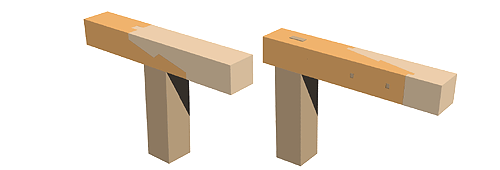|
||
 |
||
1@A generic term for joinery including spliced and angled joints. When used as a suffix in compounds, the te θ is often dropped.
2@To join timbers end to end to increase their length; end or butt joints. Japanese joinery is divided broadly into two basic types: butt or straight joints, tsugite, and angle joints *shiguchi dϋ. Consideration must be given to parts of the tree from which the timber has been cut. There are three basic arrangements: a) yukiaitsugi sp, to join timber ends which were both close to the top of the trunk sueguchi ϋ; b) wakaretsugi Κp, to join ends from the base of the trunk motoguchi ³ϋ; c) okuritsugi p, to join two timbers, one end of which came from the upper part of the trunk and the other from the base. It is also important to note the location of the jointed member in relation to the timber to which it is attached: *shintsugi ^p, the joint itself is squarely set upon a supportive member such as a pillar; mochidashitsugi op, the joint itself is in part of the member which extends beyond the supportive timber. This results in a certain weakness in the jointed member. Finally, the most fundamental methods of joinery include: a) kirikumitsugi Ψgp, a joint dependent upon tenon *hozo ΩΌ, and mortise *hozoana ΩΌ; b) *koshikaketsugi |p, a lapped joint; c) soegi itatsugi YΨΒp or soegitsugi YΨp, a splint or brace joint; d) *sogitsugi Ep, a scarf joint.
| @ | ||||||||
 |
||||||||
|
||||||||
| @ | ||||||||
 |
||||||||
|
||||||||
@
(C)2001 Japanese Architecture and Art Net Users System.@No reproduction or republication without written permission.
fΪΜeLXgEΚ^ECXgΘΗASΔΜRecΜ³f‘»E]ΪπΦΆά·B

